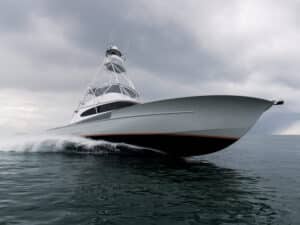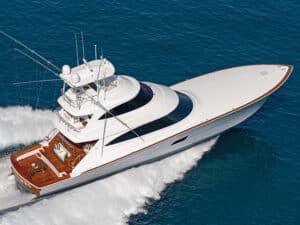
0610br_rivera_368
Not that long ago, serious anglers snarled at the idea of a pod-powered sport-fisher. When Volvo introduced the IPS systems in 2004, they were primarily being installed on comfort-focused express-style cruisers. But the times they are a-changin’.
One of the first builders to flirt with the IPS systems in the sport-fish market was Paul Spencer, with his IPS-powered Spencer 43 Express. The most obvious benefit came in the expanded accommodations on this style of boat, created by placing the engines aft, under the cockpit. However, efficiency and exhaust-free operation afforded by IPS drives proved a plus to anglers as well. And the fish-fighting maneuverability proved second to none!
As the system becomes more readily accepted by die-hard fishermen, many more production boatbuilders now embrace Volvo IPS (as well as Zeus and ZF-propelled boats) for fishing applications. Australia’s Riviera represents a prime example of a builder that took a good boat and expanded its appeal by offering optional IPS power. Riviera built 158 conventional shaft-drive 51s since introducing the model in 2002, and the IPS option is pumping new life into this proven hull.
Performance
While testing a fully loaded 51 off Grahams Point, south of Sydney, Australia, the boat’s smooth running characteristics impressed me. Pushing the electronic controls all the way forward resulted in an effortless rise out of the hole with no protest from the three, six-cylinder, 435 hp IPS 600 turbocharged and supercharged diesels resting snuggly under the cockpit. We

achieved a top speed of 29.9 knots and then backed off to 3,000 rpm, settling in with a cruising speed of 23 knots while burning a total of 48 gph. At this speed, we measured a whisper-like sound reading of 68 decibels (the normal level of conversation is 64). And as an added bonus, the 51 was a blast to drive and greeted the building head sea coming into the inlet with ease, settling gently back into the trough. The IPS drives delivered a rapid response at the helm – the 51 lost only 1½ knots when turned hard over, spinning around in less than a boat length.
Flybridge
The line of sight from the centerline helm on the semienclosed bridge is good. All the breakers are easily accessible, although personally, I would like to see the engine gauges placed lower in the line of sight, instead of above the helmsman on the overhead console. There is more than enough space to include them on the large, three-panel electronics display. To keep an eye on the cockpit action, you’ll need to use the aft bridge station. (Find a third station in the cockpit.) Our boat featured a wet bar to port, which I would forgo in order to keep the standard aft-facing bench seat, a perfect spot from which to watch your baits. A large U-shaped settee with a table sits to port. By opening the aft isinglass drop curtains, the side windows and overhead hatch, the 51’s bridge morphs into an open layout. A standard bridge is also available, which places the helm farther aft. And the entire flybridge enjoys air conditioning for your cruising comfort.
Interior
A staircase to the salon provides access to the lower deck. As is customary on sport-fish models outside North America, the 51 has a three-panel forward-facing windshield in the salon, which can be ordered as a solid front with attendant storage space in the brow. Beneath the salon is a huge space where the engines used to be. The fuel tank remains on centerline, and behind the tank you’ll find an open stowage area. On our boat, it held deck chairs, food, cases of wine and beer, and various water toys. With a little creativity, the space could turn into an incredible tackle locker with plenty of rod storage. The space also holds the generator, pumps and air-conditioning unit, creating an easy service environment. Riviera offers an option to fit this out as crew stateroom and head as well.
Cockpit
The aft portion of the cockpit lifts to access the triple IPS 600s. Surprisingly, there is ample space on all sides of the engines for routine service. If you’re in a sloppy seaway with boarding seas and need to service the engine, you can alternatively gain access to the engine compartment from the salon. I would hesitate to open the large cockpit hatch in nasty conditions.
The cockpit features a lighted livewell, tackle-prep station, fish boxes and additional stowage along the sides of the cockpit. Riviera glasses in a backing plate to make every cockpit ready to accept the installation of a fighting chair.
The wide side decks take some of the gymnastics out of the passage to the foredeck, and our boat was equipped with side rails down three-quarters of the gunwale. If you want to dial your 51 up for a more tournament-ready profile, you can choose an optional pulpit treatment.
The fit-and-finish of the interior is well executed, with extra attention given to utilizing every available inch of dead space. This boat could easily head off to Mexico or the Bahamas filled with everything a demanding crew needs. Thanks to large overhead hatches, the master stateroom to starboard doesn’t feel as cave-like as some convertible designs. Another double is forward, and a second guest stateroom with twin bunks lines the port passageway.
Like a lot of boatbuilders these days, Riviera took some hits in the recent economic downturn. Yet after two factory visits in the past 12 months, it’s obvious to me that the company is once again investing in new products and looking forward. Oh, and lest the thought of owning a boat whose builder resides on the other side of the world gives you pause, Riviera has a full-service sales and maintenance facility in Stuart, Florida, too.
Specifications
LOA……58’2″
Beam……16’2″
Draft……3’8″
Deadrise……15 degrees
Weight……48,060 pounds
Fuel……978 gallons
Water……227 gallons
Power……Triple 435 hp Volvo IPS 600 diesels
Price……On request
The Riviera Group / Stuart, Florida / 772-872-7260 / www.riviera.com.au







